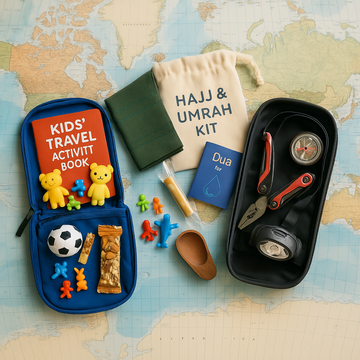Have you ever found yourself seated on a plane, gazing at the vast blue sky, eagerly anticipating the adventures that await you, only to realize that your serene journey has turned into a battle against sudden sneezing fits, itchy eyes, or even severe allergic reactions mid-flight? These stories are not mere anecdotes but rather a reality experienced by many.
According to statistics from the World Health Organization (WHO), hundreds of millions of people worldwide suffer from nasal inflammation, with over 300 million estimated to have asthma. These numbers reflect the daily lives of individuals who find themselves grappling with allergies even in the expansive skies. Therefore, in this article, we'll explore how travelers with allergies can soar safely, navigating obstacles to reach destinations free from sneezes and itching.
The Factors Leading to Allergies on Aircraft
There are many factors that can make air travel challenging for individuals with allergies. In the following, we will examine some of these factors:
Food Allergens
In-flight meals and snacks may contain common allergens such as peanuts, tree nuts, and dairy, posing a risk to passengers with food allergies.
Accumulation of Dust
The buildup of dust and mites in the tight spaces of an aircraft poses a significant challenge for those with allergies. These tiny particles, invisible to the eye, can cause sneezing, congestion, and itchy eyes.
Animal Dander
Pets traveling onboard with their owners can leave behind a trail of animal dander, a common allergen that can trigger allergic reactions in susceptible individuals.
Perfumes and Odors
The use of strong perfumes by fellow passengers can trigger allergic reactions in sensitive individuals. Airborne particles from perfumes can irritate the respiratory system, leading to symptoms such as coughing, wheezing, and shortness of breath.
Environmental Allergens
Airborne allergens such as pollen, mold spores, and dust mites may enter the aircraft cabin through ventilation systems or open doors, triggering allergic reactions in sensitive individuals.
7 Tips for Safe Travel Without Allergies:
1- Pack Essentials
Ensure you pack all necessary medications for managing allergies in your carry-on luggage. This includes antihistamines to alleviate symptoms like itching and sneezing, and epinephrine auto-injectors for severe allergic reactions. Having these essentials readily accessible can be lifesaving in case of an emergency during the journey.
2- Stay Hydrated
Drink plenty of water throughout the flight to keep your mucous membranes hydrated. Dry air in the aircraft cabin can exacerbate allergy symptoms, so staying hydrated can help alleviate discomfort and maintain overall well-being during the journey.
3- Avoid Triggers
Be proactive in avoiding potential allergens that may be present during the journey. This includes common triggers like peanuts, tree nuts, pet dander, and strong fragrances. Be vigilant about reading ingredient labels on snacks and meals provided onboard and politely decline items that may pose a risk to your health.
4- Clean Surroundings
Take proactive steps to minimize exposure to allergens by cleaning your immediate surroundings. Use disinfectant wipes to thoroughly clean your seating area, tray table, and armrests before settling in. This simple precaution can help reduce the risk of coming into contact with allergens left behind by previous passengers.
5- Wear a Mask
Consider wearing a protective mask, especially during periods of high pollen seasons or in crowded environments where allergen exposure may be heightened. A mask can serve as a barrier against airborne allergens, providing an added layer of protection for individuals with allergies.
6- Inform Airlines:
Make sure to notify the airline of your allergy. You can request accommodations such as seating away from individuals with allergies or medical conditions, or sitting far from pets to ensure a safer journey. Providing this information allows the airline to make necessary arrangements to accommodate your needs.
7- Using Allergy-Proof Seat Covers
Using allergy-proof seat covers can be a wise step to safeguard yourself and may also help reduce exposure to dust mites and allergens. These covers are designed to act as a barrier between the traveler and the seat, minimizing direct contact with allergy-causing substances. Here are some general facts about these covers:
-
Protection from Common Allergens: Serving as a barrier between the traveler and the seat, these covers help protect against dust mites, dust, pet dander, and other allergens.
-
Antimicrobial Materials: Some covers are made from materials that resist bacteria and viruses, providing an extra level of protection.
-
Ease of Use and Portability: Lightweight, foldable designs make them easy to carry and use anytime.
-
Easy to Clean: They can be washed and reused, offering an eco-friendly option compared to single-use covers.
- Softness: These seat covers boast a luxurious softness that provides unparalleled comfort, ensuring a pleasant and irritation-free experience throughout your journey.
You can enjoy all these benefits by choosing Your Shield, where we offer seat covers specifically designed for airplane seats, which can also be used in hotels with outstanding features. Renowned for their softness and diverse designs suitable for both adults and children, they are lightweight, easy to carry, washable, and reusable. Most importantly, they will protect you from contracting any diseases that may be transmitted to you through airplane seats.
Simply head to the Catalog list and select the product that aligns with your personal requirements and preferences. Should you encounter any challenges or need additional information about the product, our dedicated customer service team is here to provide you with prompt and helpful support. Your satisfaction is our top priority, and we're committed to ensuring a seamless shopping experience for you.


